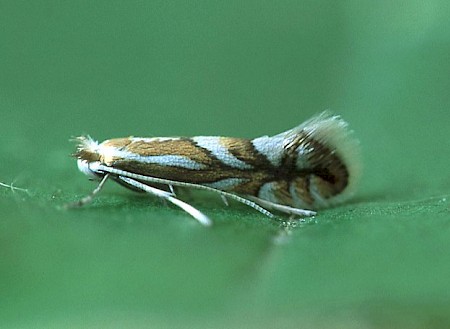15.044 BF324
Phyllonorycter sorbi
(Frey, 1855)
Wingspan 7-9 mm.
Distributed throughout the British Isles, this species is generally commoner in the northern half.
It flies in April and May and again in August. The forewing colour is golden brown but is often suffused with blackish on the outer half. The white markings are well defined and partially bordered blackish.
The larva feeds in a leaf-mine, which is wrinkled on the underside and curved into a tube on the upper surface. The whole leaflet is often strongly contorted. The most usual foodplant is rowan (Sorbus aucuparia), but it is sometimes found on bird-cherry (Prunus padus) and other species of Sorbus including Swedish whitebeam (Sorbus intermedia).
- Larva: (description Ian F. Smith):
The larval stage occurs late June - July and September - October. The larvae of all Phyllonorycter species are very similar, and differentiation of species is best done by foodplant and mine form. The first three instars are legless and flattened, with the thorax notably wider than the abdomen. The last two instars are cylindrical with thoracic legs and abdominal prolegs. Early instar P. sorbi larvae are greenish yellow, with a paler thorax and the gut showing dark green in the abdomen. Later instars can be shining golden yellow, with a paler thorax and a dark orange gut. The head is pale brown. The prothoracic shield is wrinkled and coloured as the thorax. There is a dark brown anal plate.
To obtain adults, collect leaf-mines containing pupae in late July for moths in August, or collect in late October, store outside to avoid desiccation, and bring indoors ten days before emergence is required during March or April.

 UKMoths
UKMoths 





